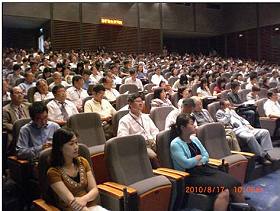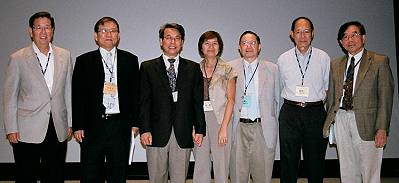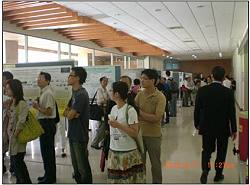NHRI Communications

會議報導
99年度國家衛生研究院生物醫學學術研討會紀實
NHRI reports on 2010 Biomedical Research Symposium
 99年度國家衛生研究院生物醫學學術研討會(2010 Biomedical Research Symposium of NHRI)於今年8月17日至18日假本院會議中心舉行。此次會議除有整合性計畫研究人員參與外,亦邀請院外計畫學術審查之國內、外專家60餘位共同與會,另開放本院研究人員及國內各機構研究人員報名與會,總計人數達約510人次,可謂盛況空前,充分達到學術交流之目的。
99年度國家衛生研究院生物醫學學術研討會(2010 Biomedical Research Symposium of NHRI)於今年8月17日至18日假本院會議中心舉行。此次會議除有整合性計畫研究人員參與外,亦邀請院外計畫學術審查之國內、外專家60餘位共同與會,另開放本院研究人員及國內各機構研究人員報名與會,總計人數達約510人次,可謂盛況空前,充分達到學術交流之目的。本院自2008年起,於每年8月暑假期間,藉由辦理涵蓋各領域的國際學術研討會方式與國內外學者進行交流,除了展現本院當年度所支持的院內、外研究成果,更冀望成為國內外生醫學界朋友在暑期積極參與的學術盛事。
 此次會議首日上午由本院伍焜玉院長主持開幕,隨後邀請美國加州大學爾灣分校生物化學系李文華院士以「Genetic Principles of Cancer Origin: An Overview註1」為題發表演說;次日上午則邀請中央研究院基因體研究中心陳建仁院士以「End-stage Liver Disease Risk Prediction in Patients Affected with Chronic Viral Hepatitis註2」為題發表演說。
此次會議首日上午由本院伍焜玉院長主持開幕,隨後邀請美國加州大學爾灣分校生物化學系李文華院士以「Genetic Principles of Cancer Origin: An Overview註1」為題發表演說;次日上午則邀請中央研究院基因體研究中心陳建仁院士以「End-stage Liver Disease Risk Prediction in Patients Affected with Chronic Viral Hepatitis註2」為題發表演說。本次會議另規劃「Cancer Research」、「Neural Science」、「Biomedical Science」、「Medical Engineering」、「Molecular Genetics and Medicine」及「Population Health Research」等6項口頭報告主題,邀請24位執行成果優良之整合性醫藥衛生科技研究計畫主持人及本院研究人員,於2個會場同步進行口頭報告,分享其研究成果與經驗,促進學術交流及研究合作。
 囿於口頭報告場次有限,本次會議另安排兩個壁報時段(poster session),由整合性計畫主持人及本院研究人員張貼壁報展示研究成果(共計發表118篇壁報論文),並於第二天下午特別安排分組壁報論文討論會議(poster discussion),由各組會議主持人邀請部分壁報展示之研究人員簡短報告分享研究成果,以促進壁報發表者、計畫主持人、所有分組與會人員及學術審查委員間之討論與互動,除有助於委員了解計畫執行成效,亦能協助解決研究過程可能遭遇之困難。
囿於口頭報告場次有限,本次會議另安排兩個壁報時段(poster session),由整合性計畫主持人及本院研究人員張貼壁報展示研究成果(共計發表118篇壁報論文),並於第二天下午特別安排分組壁報論文討論會議(poster discussion),由各組會議主持人邀請部分壁報展示之研究人員簡短報告分享研究成果,以促進壁報發表者、計畫主持人、所有分組與會人員及學術審查委員間之討論與互動,除有助於委員了解計畫執行成效,亦能協助解決研究過程可能遭遇之困難。本次會議所舉辦的演講、壁報論文發表及分組討論皆引起熱烈的問答討論,往往欲罷不能,其間的腦力激盪對促進與會者之交流與互動,卓有成效且獲益良多,期能達到研究合作及團隊形成之目標。
註1:李文華院士演講摘要
Genetic Principles of Cancer Origin: An Overview
Mutations of genes participating at different levels of cell physiology have been found in all kinds of cancers. These genes can be divided into two categories- oncogenes and tumor suppressor genes. Mutations in oncogenes result in increased activity, while mutations in tumor suppressor genes diminish their function. The end result from such genetic alterations frequently leads to abnormalities in many cell behaviors, including growth, differentiation and cell death. In this overview, I plan to focus on the genetic mode of action of the suppressor genes on the initiation of cancer.
Many tumor suppressor genes require both copies to be deleted before cells display an oncogenic phenotype. The retinoblastoma gene (RB) is the prototype of tumor suppressor genes, which is found to be completely inactivated in all cases of childhood retinoblastoma. RB mainly functions in cell cycle progression and maintains genome stability by monitoring chromosome segregation fidelity. Wild-type p53 is lost in many human tumors, and both BRCA1 alleles are completely inactivated in some breast and ovarian cancers. These genes have significant transcriptional roles in regulating gene expression and maintaining genome stability through regulation of the DNA damage repair pathway. Interestingly, reintroduction of one wild-type allele suppresses tumor growth by inducing cell cycle arrest, apoptosis or differentiation.
Other suppressor genes, such as the Mismatch repair genes (MMR), Werner syndrome gene (WNS), and Bloom's syndrome gene (BLM), directly participate in DNA repair. Defects in MMR genes led to mutations of the type II TGF-βreceptor and cause Hereditary Non-polyposis Colorectal Cancer (HNPCC). Unlike cells with mutations in RB, or p53, reintroducing the MMR gene back into HNPCC cells cannot suppress tumor progression, presumably because the TGF-β receptor was already inactivated.
Another group of suppressor genes required only one allele inactivation for tumorigenesis, despite retaining one active wild-type allele. This haploinsufficiency effect is seen for the CtIP, RINT1, Smad4, AML1and p27KIP1 genes. It is expected that the list of this kind of suppressor genes will be long.
Recently, we found that the inactivation of one mouse Suv3 allele reduces lifespan and predisposes over 90% of the animals to tumor formation. This effect is in part the product of inherited mtDNA damage, since backcross offspring derived from mSuv3+/- females and C57BL6 males retain these phenotypes while offspring from mSuv3 +/- males and C57BL6 females have attenuated phenotypes. The maternal transmission of these phenotypes together with the observed increase in mtDNA mutation load and reduced mtDNA copy number suggest that the observed phenotypes are the consequence of SUV3 insufficiency and subsequent mtDNA instability. Therefore, SUV3 is a novel tumor suppressor, which functions in a dosage-dependent manner to maintain the integrity of the mtDNA.
In conclusion, the contribution of genetic mutations on a given gene to cancer initiation depends on the nature of the mutation, the function of the gene, the origin of cell type, and the cellular microenvironment. The intertwining relationship of those factors is enormously complicated. Elucidating the genetic basis of cancer origins remains extremely challenging.
註2:陳建仁院士演講摘要(演講內容請見本期「影音節目」)
End-stage Liver Disease Risk Prediction in Patients Affected with Chronic Viral Hepatitis
Both hepatitis B virus (HBV) and hepatitis C virus (HCV) are major causes of end-stage liver diseases including cirrhosis and hepatocellular carcinoma (HCC). An estimated 400 million people worldwide are living with chronic HBV infection, and 200 million with chronic HCV infection. Each year, an estimated 500,000 people die of HCC caused by chronic HBV infection, and another 200,000 HCC cases caused by chronic HCV infection. The prevalence of chronic HBV and HCV infection is uneven throughout the world, with significant burdens in Asia and the Pacific Islands and sub-Saharan Africa.
The most important risk predictors of liver cirrhosis and HCC in persons who have chronic HBV infection are persistently elevated serum levels of HBV DNA and alanine aminotransferase (ALT). Other HCC risk predictors for chronic hepatitis B patients include HBV genotype C infection, HBV basal core promoter A1762T/G1764A mutants, male sex, older age, family HCC history, habitual alcohol consumption, and co-infection with HCV or HIV. Based on the dataset of REVEAL-HBV study, easy-to-use nomograms using noninvasive clinical characteristics have been developed for accurate prediction of hepatocellular carcinoma risk in patients with chronic hepatitis B. The HCC risk calculator derived from R.E.V.E.A.L.-HBV study have been validated by follow-up data from clinical cohorts in Hong Kong and Korea.
The most important predictors of HCC risk in persons who have chronic HCV infection include elevated serum levels of HCV RNA and ALT, HCV genotype and older age. In the R.E.V.E.A.L.-HCV study, participants with detectable HCV RNA level, elevated serum ALT levels and genotype 1 HCV infection had the highest risk of hepatocellular carcinoma showing a multivariate-adjusted hazard ratio (95 percent confidence interval) of 21.87 (5.09-93.95).compared with those with undetectable HCV RNA level and low serum ALT levels as the referent group. These findings have strong implications for the management of chronic hepatitis C.
References:
1. Chen CJ et al. Risk of hepatocellular carcinoma across a biological gradient of serum hepatitis B virus DNA level. JAMA2006;295:65-73.
2. Iloeje UH et al. Predicting cirrhosis risk based on the level of circulating hepatitis B viral load. Gastroenterology 2006;130:678-686.
3. Iloeje UH et al. Risk and predictors of mortality associated with chronichepatitis B infection. Clin Gastroenterol Hepatol 2007;5:921-931.
4. Yang HI et al. Association between Hepatitis B virus genotype and mutants and the risk of hepatocellular carcinoma. J Natl Cancer Inst 2008;100:1134-1143.
5. Chen et al. Hepatitis B virus DNA levels and outcomes in chronic hepatitis B. Hepatology 2009;49:S72-S84.
6. Yang et al. Nomograms for risk of heptocellular carcinoma in patients with chronic heaptitis B virus infection.J Clin Oncol 2010; 28:2437-2444.
7. Lee et al. Hepatitis C virus seromarkers and subsequent risk of hepatocellular carcinoma: Long-term predictors from a community-based cohort study. J Clin Oncol 2010 (in press).
《文/圖:學術發展處蕭振祥》